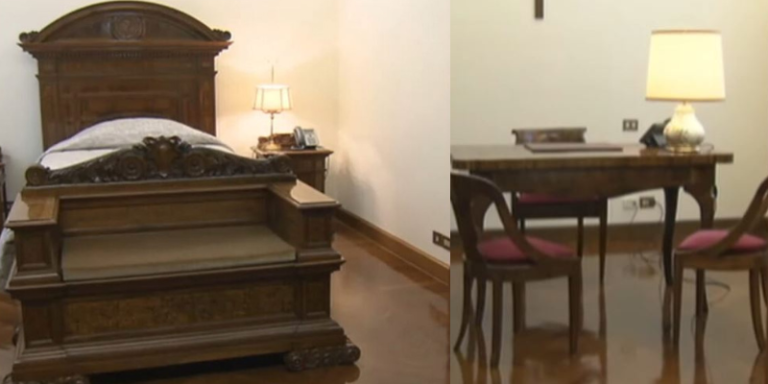With the flip of a key, Pope Francis subtly destroyed grandeur in a time of spectacle, where status symbols are displayed like medals of achievement. That key opened Room 201 of Casa Santa Marta, a small guesthouse located inside Vatican City, but it did not open the doors to the Apostolic Palace. His decision was a purposeful break from centuries of papal tradition and a powerful reflection of the life he advocated. It was neither fanciful nor fleeting.
Pictures of Pope Francis’ bedroom have sparked a wave of online awe, discussion, and reflection over the past week. There is no sign of royal indulgence in the sparsely furnished, dimly lit room, which is anchored by a single wooden bed. It’s monastic, not merely minimalist. The rest of the room is simple, almost austere, with a simple crucifix hanging over a modest desk. Something incredibly rich, however, is concealed within that sparseness: a declaration of integrity conveyed by consistent, modest living rather than words.
Profile Summary of Pope Francis
| Attribute | Details |
|---|---|
| Full Name | Jorge Mario Bergoglio |
| Papal Name | Pope Francis |
| Date of Birth | December 17, 1936 |
| Place of Birth | Buenos Aires, Argentina |
| Date of Death | April 21, 2025 |
| Papal Tenure | March 13, 2013 – April 21, 2025 |
| Residence as Pope | Room 201, Casa Santa Marta, Vatican City |
| Known For | Simplicity, inclusivity, Jesuit reform, climate advocacy |
| Salary | $0 – Declined the monthly $32,000 papal income |
| Final Resting Place | Basilica of Santa Maria Maggiore |
| Notable Quote | “I cannot live without people. I need to live my life with others.” |
Pope Francis wasn’t avoiding tradition for the sake of provocation when he rejected luxury. Quietly but deliberately, he was bridging the gap between ordinary humanity and spiritual leadership. His method was especially helpful to a religion that was having a hard time staying relevant in a changing environment. He slept under a wooden crucifix rather than gold-leafed frescoes, walked among people, and ate with staff in communal dining halls rather than ruling from a gilded tower.
This was a deeply intentional lifestyle, not a performative one. As a Jesuit, the Pope made a commitment to chastity, poverty, and obedience. Pope Francis, however, lived out those promises every day. And in doing so, he improved his office’s reputation in a manner that no luxury could have achieved. His life did not contradict his words, which is precisely why his leadership was so successful in raising awareness of social issues.
Throughout his twelve years as pope, Francis defied established convention. He promoted LGBTQ+ inclusion, fought for climate action, and elevated women to senior positions throughout the Vatican—actions that were especially novel for a traditionally conservative organization. Nevertheless, doing less was possibly his most audacious move. living more modestly. Just sleeping.
This perspective transforms the Pope’s bedroom into a living parable rather than just a private area. A silent sermon in woods. Millions of people share these pictures on social media, and while some find them humorous due to their starkness, others see in them a rare example of leadership—one that consistently and unwaveringly demonstrates what it believes in.
The message is crystal clear for aspiring clergy, young leaders, and even nonreligious observers. Building respect doesn’t require velvet robes. You must have a purpose. You must be present. Above all, you must live up to the principles you say you support.
FAQs: Pope Francis’ Bedroom and His Choices
- Where did Pope Francis sleep?
In Room 201 of Casa Santa Marta, not the Apostolic Palace. - Why was his room so simple?
As a Jesuit, he upheld vows of poverty and chose humility over grandeur. - Did the Pope take a salary?
No, he declined the standard $32,000 monthly papal income. - What was in his room?
A small bed, crucifix, wardrobe, and a desk—nothing lavish. - Why is this significant?
It reflects how Francis truly lived the values he preached.


